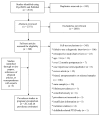The Prevalence of Anxiety Disorders During Pregnancy and the Postpartum Period: A Multivariate Bayesian Meta-Analysis
- PMID: 31347796
- PMCID: PMC6839961
- DOI: 10.4088/JCP.18r12527
The Prevalence of Anxiety Disorders During Pregnancy and the Postpartum Period: A Multivariate Bayesian Meta-Analysis
Abstract
Objective: To estimate the prevalence of anxiety disorders in pregnant and postpartum women and identify predictors accounting for variability across estimates.
Data sources: An electronic search of PsycINFO and PubMed was conducted from inception until July 2016, without date or language restrictions, and supplemented by articles referenced in the obtained sources. A Boolean search phrase utilized a combination of keywords related to pregnancy, postpartum, prevalence, and specific anxiety disorders.
Study selection: Articles reporting the prevalence of 1 or more of 8 common anxiety disorders in pregnant or postpartum women were included. A total of 2,613 records were retrieved, with 26 studies ultimately included.
Data extraction: Anxiety disorder prevalence and potential predictor variables (eg, parity) were extracted from each study. A Bayesian multivariate modeling approach estimated the prevalence and between-study heterogeneity of each disorder and the prevalence of having 1 or more anxiety disorder.
Results: Individual disorder prevalence estimates ranged from 1.1% for posttraumatic stress disorder to 4.8% for specific phobia, with the prevalence of having at least 1 or more anxiety disorder estimated to be 20.7% (95% highest density interval [16.7% to 25.4%]). Substantial between-study heterogeneity was observed, suggesting that "true" prevalence varies broadly across samples. There was evidence of a small (3.1%) tendency for pregnant women to be more susceptible to anxiety disorders than postpartum women.
Conclusions: Peripartum anxiety disorders are more prevalent than previously thought, with 1 in 5 women in a typical sample meeting diagnostic criteria for at least 1 disorder. These findings highlight the need for anxiety screening, education, and referral in obstetrics and gynecology settings.
© Copyright 2019 Physicians Postgraduate Press, Inc.
Conflict of interest statement
Figures



Comment in
-
Screening for Perinatal Anxiety Symptoms in Obstetric Settings Is Recommended, and Proper Provider Training Is Essential.J Clin Psychiatry. 2019 Jul 23;80(4):19com12939. doi: 10.4088/JCP.19com12939. J Clin Psychiatry. 2019. PMID: 31347794 No abstract available.
References
-
- Kessler RC, Berglund P, Demler O, et al. Lifetime prevalence and age-of-onset distributions of DSM-IV disorders in the national comorbidity survey replication. Arch Gen Psychiatry. 2005;62(6):593–602. - PubMed
-
- Fifer SK, Mathias SD, Patrick DL, et al. Untreated anxiety among adult primary care patients in a health maintenance organization. Arch Gen Psychiatry. 1994;51(9):740–750. - PubMed
-
- Fournier L, Lesage AD, Toupin J, et al. Telephone surveys as an alternative for estimating prevalence of mental disorders and service utilization: a Montreal catchment area study. Can J Psychiatry. 1997;42(7):737–743. - PubMed

